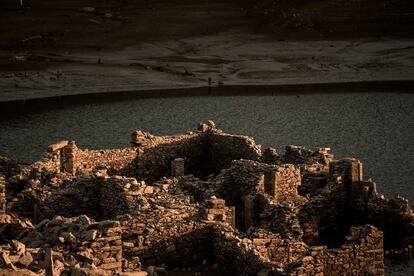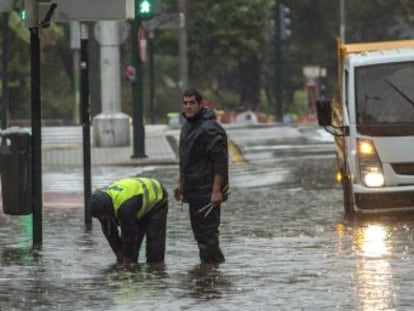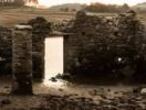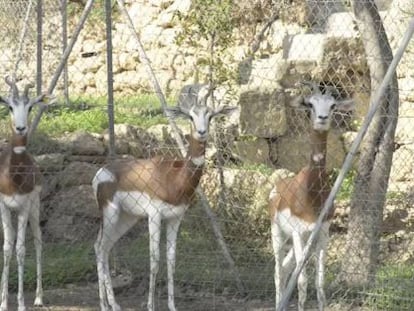A ghostly Galicia emerges from the waters
As northwestern region suffers worst drought in decades, reservoirs reveal once-flooded villages
Somebody has laid flowers at the foot of the oak of the hanged. This impressive, but long-dead tree has been left exposed as the waters have receded at the Portodemouros reservoir in Agolada, a tiny community in Pontevedra province in the northwestern region of Galicia.
Some in the area say that the oak, which has been submerged since the surrounding valley was flooded in 1967 under a policy of hydro-electric generation initiated by General Francisco Franco, was once the site of a number of grim events. Today, it stands alone on the edge of the once-prosperous village of Marquesado, if its sturdy walls, pillars and stone lintels now visible due to the lengthy drought in Galicia are anything to go by.
This summer has been the driest since 1981
The region’s two hydrographic demarcations, Galicia Costa and Miño-Sil, are on pre-alert, with reservoirs at around 45% capacity. The regional water authority, Augas de Galicia, has issued warnings to businesses and households to “use water responsibly.” Meanwhile, villages that were left submerged during the Franco years are enjoying a brief new lease of life as tourists visit them at the weekends. Dozens of hamlets, roads, bridges, vineyards and even prehistoric ruins and Celtic hillforts are basking in the sun while other areas of Spain are being inundated with torrential rain.
The Fervenza reservoir, close to the communities of Mazaricos, Vimianzo, Dumbría and Zas, in neighboring A Coruña province to the north, is at 20% capacity. Seven months of scant rainfall has uncovered a megalithic burial mound in Baíñas, which, despite being submerged for the best part of half a century, still conserves some of the dolmens that once crowned it.

At the Belesar reservoir, in Lugo province, the biggest along the Miño river, terraced vineyards have been exposed in the Ribeira Sacra wine-producing area. Wine has been made here since Roman times, and was exported in elaborate amphorae of a design still used today, and that can be found at the town of Sober.
The residents of a community that probably started out as a hill fort, Castro Candaz, on the outskirts of Chandada, which flourished in the Middle Ages, also probably made wine. The hillside could be seen in the summer months above the waters but could not be reached. But the drought has revealed an isthmus, allowing visitors to climb along its ancient walls, prompting fears among local people they could be damaged by the influx of recent months.
Last summer was the driest since 1981, followed by an autumn that Spain’s meteorological office says has produced 40% less rain than the historical average, and with a winter that so far is showing little sign of making up for things. At the other end of the Belesar reservoir, which is at 25% capacity, is the village of Portomarín, which was submerged in 1963 to feed a hydroelectric power plant. Its bridge, lanes and cemetery have emerged from the waters unscathed.

Some locals close to Aceredo, in Lobios, Ourense province, still remember having to move their church and disinter relatives as the waters rose following the decision by Portugal’s EDP electricity company to flood the area in 1992 as part of an agreement signed decades earlier, burying five villages under water.
Meanwhile, the reservoir at Lindoso has been reduced to 20% capacity, allowing visitors to wander through its narrow lanes. There are even a few lampposts standing. But the valley is not as fertile as it once was.
English version by Nick Lyne.
Tu suscripción se está usando en otro dispositivo
¿Quieres añadir otro usuario a tu suscripción?
Si continúas leyendo en este dispositivo, no se podrá leer en el otro.
FlechaTu suscripción se está usando en otro dispositivo y solo puedes acceder a EL PAÍS desde un dispositivo a la vez.
Si quieres compartir tu cuenta, cambia tu suscripción a la modalidad Premium, así podrás añadir otro usuario. Cada uno accederá con su propia cuenta de email, lo que os permitirá personalizar vuestra experiencia en EL PAÍS.
¿Tienes una suscripción de empresa? Accede aquí para contratar más cuentas.
En el caso de no saber quién está usando tu cuenta, te recomendamos cambiar tu contraseña aquí.
Si decides continuar compartiendo tu cuenta, este mensaje se mostrará en tu dispositivo y en el de la otra persona que está usando tu cuenta de forma indefinida, afectando a tu experiencia de lectura. Puedes consultar aquí los términos y condiciones de la suscripción digital.
More information

Flooding claims two lives as heavy rain hits southeastern Spain
Últimas noticias
There is as much life left to discover on planet Earth as that which is already known
Dozens presumed dead, around 100 injured in fire at Swiss Alps bar during New Year’s celebration
Is porn for women different from conventional porn? We spoke to those who make it
Cartagena de Indias is sinking: What can the city do to mitigate it?
Most viewed
- David King, chemist: ‘There are scientists studying how to cool the planet; nobody should stop these experiments from happening’
- Reinhard Genzel, Nobel laureate in physics: ‘One-minute videos will never give you the truth’
- Oona Chaplin: ‘I told James Cameron that I was living in a treehouse and starting a permaculture project with a friend’
- Sinaloa Cartel war is taking its toll on Los Chapitos
- The Interoceanic Train, the Mexican alternative to the Panama Canal












































